Ventnor
| Ventnor | |
| Hampshire | |
|---|---|
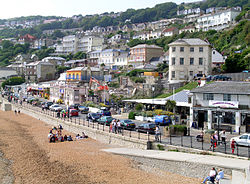 Ventnor seafront. | |
| Location | |
| Island: | Isle of Wight |
| Grid reference: | SZ562775 |
| Location: | 50°35’51"N, 1°12’30"W |
| Data | |
| Population: | 6,257 (2001) |
| Post town: | Ventnor |
| Postcode: | PO38 |
| Dialling code: | 01983 |
| Local Government | |
| Council: | Isle of Wight |
| Parliamentary constituency: |
Isle of Wight |
Ventnor is a seaside resort town on the south coast of the Isle of Wight, Hampshire. It was established as a seaside resort in the Victorian era and stands lies underneath St Boniface Down (which, at 787 feet, is the highest point on the island. The town is runs up the Down's steep slopes and cliffs leading down to the sea. The higher part is referred to as Upper Ventnor (although officially named Lowtherville); the lower part, where most of the amenities are located, being known as Ventnor. Ventnor is sometimes understood as including the coastal villages of St Lawrence to one side and Bonchurch to the other.
The sheltered location on the cliff of the Island's south coast means the area experiences a microclimate with more sunny days than much of the British Isles, and fewer frosts. This has allowed many species of subtropical plant to be successfully planted and maintained. Ventnor Botanic Garden is particularly notable.
Geology
The geomorphology of the area in many ways defines the town. It varies greatly, with a significant area built on clay which suffers from serious landslip. The ground at Ventnor is notoriously unstable, and many buildings and amenities have been lost to subsidence or cliff-falls. There is a local expression: "We live near the sea and are getting nearer every day." This has led to considerable concern and study of the situation.[1][2][3][4] This is the subject of displays at the Isle of Wight Coastal Visitors Centre in Ventnor.[5] One nearby Site of Special Scientific Interest "The Landslip".
At the top of the town is a geological fault known as the Graben, which marks the top of the series of landslips on which Ventnor is built. This fault moves regularly, and has been the cause of the destruction of numerous buildings over the years, serious cracking to the road which crosses it, and repeated disruption to the town's utilities, which are supplied by pipes and cables which have to pass over the fault. The latest evidence of the fault can be seen at the former bus stop site on ocean view road in Upper Ventnor, where a 5"-by-3" vent has opened up along the geological fault.[6]
Thre miles off the coast of Ventnor, the seabed forms a long parallel ridge and rises to within 50 feet of the surface. The action of the sea rushing up the channel and being forced between the Island and this ridge, has carved out a narrow channel of extraordinary depth known as St Catherine's Deep.
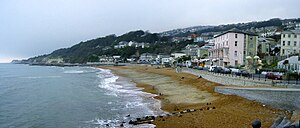
Churches
- Church of England:
- Holy Trinity Church
- St Alban
- St Boniface
- St. Catherine
- Baptist: Ventnor Baptist Church
- Methodist / United Reformed Church: United Church
- Roman Catholic: St Wilfred
History
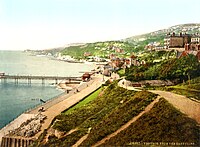
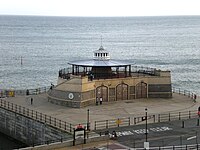
The town grew from a small fishing hamlet in the nineteenth century between the two villages of Bonchurch to the east and St Lawrence to the west. The area now occupied by Ventnor was divided between the two larger parishes of Godshill and Newchurch to the north. Charles Dickens lived nearby for some time.
It was with the coming of the Isle of Wight Railway in 1866 that the town became both a tourist and a health resort. The fresh Channel air and warm climate were considered to be very beneficial to the sufferers of tuberculosis. Several sanatoriums were established in Ventnor for those suffering from the disease. The Isle of Wight Railway at one time ran a non-stop train from Ryde to Ventnor which was named 'The Invalid Express' specifically to rush consumptive patients to their treatment at Ventnor. One train famously completed the journey in a little over twenty minutes.[7]
The town reached its zenith in the inter-war period of the nineteen-thirties with regular steam packets operating between Southsea and the town's pier. The sandy beach was ideal for bathing, and is still popular today, although it is somewhat smaller than comparable tourist beaches at nearby Sandown and Shanklin.
The railway
Ventnor railway station was the terminus of the Isle of Wight Railway (later called the Island Line) from Ryde through Sandown and Shanklin, and it brought many visitors to the town. Ventnor West railway station was the terminus of the Isle of Wight Central Railway line from Cowes through Newport. Both stations suffered from being well away from the town centre, necessitating a road journey for most travellers to reach their destination. Ventnor West station was closed in 1952, long before the closures ordered by Dr Beeching.
Ventnor station was closed in 1966, as part of a plan which also saw the remaining Ryde - Shanklin line electrified. Thereafter the town suffered a period of economic decline, from which it has not fully recovered.
However, between 2004 and 2010 a connecting Rail Link bus ran from St Lawrence and Ventnor to Shanklin, making the combined bus and rail journey to and from Ventnor easier.[8]
Ventnor Botanic Garden
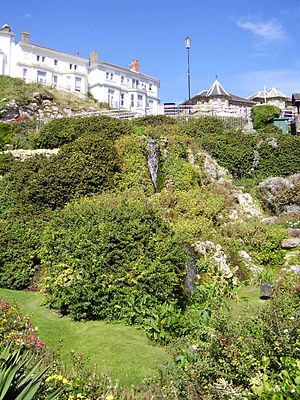
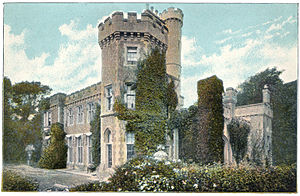
Ventnor Botanic Garden is on the site of the now-demolished Royal National Hospital for Diseases of the Chest, and has a variety of tropical plants due to Ventnor's subtropical microclimate. A rainfall of 31 inches a year and a climate more akin to the Mediterranean seaboard enable a wide variety of plants considered too tender for much of mainland Britain to be grown. The garden includes areas of plants from different parts of the world, particularly Australia and New Zealand, but also including Japan and gardens with plants of a Mediterranean origin.
Other places of interest
- Smaller Parks and Gardens: The town has a small park on the west side of town with a bandstand, aviary and stream. There is a garden crossed with a waterfall, built in the Victorian era of the town, around which winds the main path between the beach and the town. The waterfall is known as The Cascade. There is also a paddling-pool on the sea front esplanade. In the middle, rising out of the water is a model of the Isle of Wight which children can play on. The hills and inlets are physically modelled and the towns and roads (in red) are painted on. In the past, the Island's remaining railway line has also been shown (in black).
- VENTNOR Sign: There is a sign on the cliffs at La Falaise to the west of the beach which spells out the word VENTNOR in white concrete blocks, about four metres high and intended to provide a landmark visible from the sea. This replaced the chalk letters damaged in 1992. Since about the start of the current millennium, there have also been smaller metal capital letters spelling out the town's name. These are fixed to the seaward side of the water pumping station, itself sympathetically disguised as a bandstand and observation platform, next to the harbour.
- Antique and bric-à-brac stores: There are many of these in the main town shopping area, and these provide a tourist attraction in their own right.
- Ventnor Brewery: A brewery has been in Ventnor on the same location since the 1840s. Water from the local spring, which is called "St Boniface's Well" is used to make the beer.[9] The town was home to Burts Brewery, but it closed in the 1980s. After this, the site was empty for several years. The brewery was reopened as a microbrewery in 1996, called the "Ventnor Brewery" The Ventnor Brewery produces a number of cask ales, including the quite unusual Oyster Stout. Unfortunately it has been reported that brewing has ceased and the company that owned it has gone under with large debts. The brewery web site is not available now.
- RAF Ventnor High above the town exists the former site of RAF Ventnor, once an RAF radar monitoring station. Now used mainly for civilian communications antennae, the site provides views over the English Channel. However the site also contains an extensive bunker complex designed to be part of an early warning network and later converted for use as a shelter in case of a nuclear strike during the Cold War. The bunker, which was a variant on the P1 ROTOR design, has now been sealed and is generally thought to be inaccessible.
- Ventnor is on the Isle of Wight Coastal Path.
Wall Lizard
The largest British colony of Wall lizards live in walls around the town, and a wall specially designed as a habitat for them was recently built at the Botanic Garden.
Events
- Crab Fayre: Every year the town celebrates the town fair, based around the local crab harvest. It's now held at Ventnor County Middle School in Upper Ventnor.
- Carnival: Traditional town carnival held in the middle of August each year. Carnival Floats and Marching Bands
- Isle of Wight International Jazz Festival: The 3-day festival was held from 2005-2008. Headline acts included Maceo Parker, Humphrey Lyttelton and Cleo Laine.
References
- ↑ Landslips on The Isle of Wight
- ↑ West & South Isle of Wight, Standing Conference on Problems Associated with the Coastline.
- ↑ LUCCOMBE - BLACKGANG ISLE OF WIGHT (UNITED KINGDOM), Robin G. McGiness, Isle of Wight Centre for Coastal Environment
- ↑ Life on the Edge, Undercliff Matters, English Nature, Issue 2, September 2003.
- ↑ Isle of Wight Coastal Visitors Centre
- ↑ [1]
- ↑ Liberty and Locality: Parliament, Permissive Legislation, and Ratepayers' Democracies in the Nineteenth Century, John M. Prest, Clarendon Press, 1990
- ↑ "New bus link boost for Ventnor". Isle of Wight County Press. http://www.iwcp.co.uk/news/new-bus-link-boost-for-ventnor-7212.aspx. Retrieved 2009-12-22.
- ↑ St Boniface's Well (Ventnor), The Megalithic Portal.